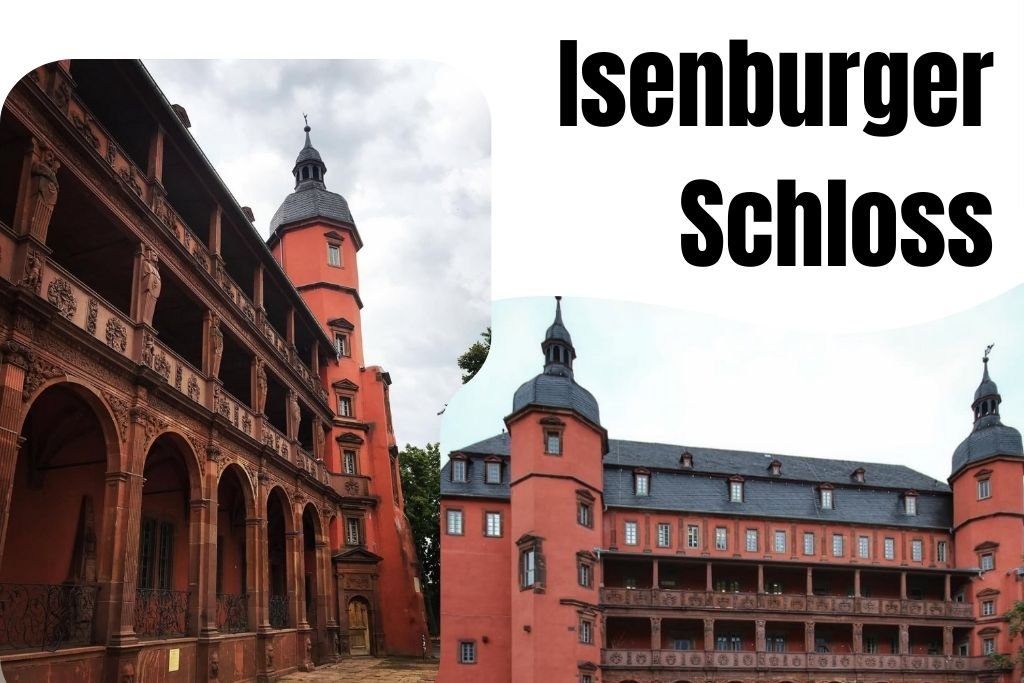Isenburger Schloss Travel Guide

Imagine standing before the Isenburger Schloss, where the Main River gently flows and centuries-old stonework whispers tales of nobility and history. This enchanting castle in Offenbach am Main, Germany, is a Renaissance masterpiece that transports you to a time of grandeur and intrigue. Its striking facade and riverside charm make it a must-see for anyone exploring the Frankfurt region.
The Isenburger Schloss, also known as Isenburg Palace, was transformed into a magnificent Renaissance palace in 1568 by Count Ludwig III von Isenburg, built on the foundations of a medieval water castle. It has witnessed pivotal moments, including negotiations during the Thirty Years’ War, and today serves as part of the Hochschule für Gestaltung (HfG) Offenbach, a renowned design school. Its historical significance and architectural beauty make it a symbol of Offenbach’s cultural heritage.
Why visit? The castle offers a chance to marvel at one of Germany’s finest Renaissance facades, soak in scenic river views, and, if timed right, experience vibrant cultural events. This guide provides everything you need to plan a memorable visit, from historical insights to practical tips.
A Journey Through Time: The History of Isenburger Schloss
Early Origins
The story of Isenburger Schloss begins in the medieval era, when the Isenburg family recognized the strategic value of its location along the Main River. Around 1394, Werner III von Falkenstein constructed a water castle here, designed as a defensive fortress to protect the region’s trade routes.
History
In 1568, Count Ludwig III von Isenburg transformed the water castle into a splendid Renaissance palace, marking its rise as a center of power and culture. The castle played a significant role during the Thirty Years’ War (1618–1648), hosting negotiations that shaped the conflict’s outcome. Notably, it was here that Frankfurt’s city keys were handed to Swedish King Gustav Adolf, a pivotal moment in the war. The Isenburg family resided here until the 19th century, when they lost control of the region to the Grand Duchy of Hesse-Darmstadt in 1816.
Architectural Evolution
The castle’s architecture is a testament to its evolution. The south facade, facing the city, boasts an exquisite Renaissance design with arcades between two stair towers, considered one of the finest Renaissance facades north of the Alps. The north side, facing the Main River, retains a more defensive, medieval character, crowned by an 18th-century baroque mansard roof. A devastating air raid in 1943 damaged much of the structure, but restoration efforts have preserved its historical essence.
Legends and Lore
While Isenburger Schloss lacks widely known myths or ghost stories, its historical significance fuels intrigue. The castle’s role in the Thirty Years’ War and its association with the powerful Isenburg family spark tales of political maneuvering and noble life. Local lore often highlights the castle as a symbol of Offenbach’s growth from a small trading post to a bustling city.
The Schloss Today
Today, Isenburger Schloss is part of the HfG Offenbach campus, hosting design students rather than nobility. The interior is not open to the public, but the exterior remains accessible, with information boards (in German) providing historical context. The HfG occasionally organizes exhibitions, parties, and cultural events, making it a dynamic space for art and design enthusiasts. Check HfG’s website for event schedules.
What to See and Do at Isenburger Schloss: A Detailed Exploration
Exploring the Interior
The interior of Isenburger Schloss is not accessible to the public, as it is used by the HfG. However, the castle’s exterior and grounds offer plenty to explore, and information boards provide insights into its history.
Wandering the Exterior and Grounds
- Courtyards and Gardens: The castle’s courtyard is open to visitors, showcasing the stunning south facade with its Renaissance arcades and stair towers. While formal gardens are absent, the courtyard’s open space invites leisurely strolls.
- Towers and Ramparts: The castle’s towers are not accessible, but their imposing presence can be admired from the ground, hinting at the fortress’s defensive past.
- Outer Walls and Defenses: The north facade, facing the Main River, features older, more fortified elements, reflecting its medieval origins. This contrast with the ornate south side is a highlight for architecture buffs.
- Scenic Viewpoints: The castle’s riverside location offers picturesque views of the Main River, especially from the nearby promenade. It’s a perfect spot to relax and take in the scenery.
Activities and Events
- Guided Tours: Traditional guided tours are unavailable due to the castle’s use as a university campus. However, self-guided walks around the exterior, aided by information boards, allow visitors to explore at their own pace.
- Special Events: The HfG hosts occasional exhibitions, parties, and cultural events, which may include access to parts of the castle. Check HfG’s events page or their social media for updates.
- Photography Opportunities: The castle’s Renaissance facade, riverside setting, and courtyard are ideal for photography, particularly during golden hour when the light enhances the red-hued walls.
Planning Your Visit: Practical Information
How to Get There
- By Car: From Frankfurt, take the A3 highway toward Würzburg, exit at Offenbach, and follow signs to the city center. Parking is available near the castle along Mainstraße or nearby streets.
- By Public Transportation: Take the S-Bahn (S1, S2, S8, or S9) from Frankfurt to Offenbach Hauptbahnhof (about 10 minutes). From there, take bus 101 or 102 to the “Schloss” stop, or walk 10–15 minutes to the castle.
- Accessibility: The castle grounds are generally accessible for those with mobility challenges, but uneven surfaces may pose difficulties. The interior is not open to visitors, so accessibility accommodations are limited.
Opening Hours and Admission Fees
The castle’s exterior and grounds are accessible year-round during daylight hours, with no admission fees. As a university campus, visitors should respect restricted areas and ongoing activities.
Best Time to Visit
Spring (April–June) and summer (July–August) offer pleasant weather for exploring the grounds and enjoying riverside views. Autumn (September–October) brings colorful foliage, while winter (November–March) is quieter but colder. Check HfG’s events page for special events to enhance your visit.
Duration of Visit
Exploring the castle’s exterior, reading information boards, and enjoying the river views typically takes 30 minutes to an hour. Pairing the visit with nearby attractions can extend your day.
Facilities and Amenities
On-site facilities are limited, but Offenbach’s city center, a short walk away, offers cafes, restaurants, and public restrooms. Souvenir shops are scarce, but nearby museums may have gift shops.
Nearby Attractions
Extend your visit with these nearby sites:
- German Leather Museum (Deutsches Ledermuseum): Explore leather artifacts from medieval times to today.
- Klingspor Museum: Discover typography and graphic design exhibits.
- Büsing Palais: Attend concerts or visit its historical grounds.
- Wetterpark: A weather-themed park run by the German Weather Service.
- Main River Promenade: Perfect for a scenic walk or picnic.
| Attraction | Distance from Schloss | Highlights |
|---|---|---|
| German Leather Museum | 1 km | Leather artifacts, shoe museum |
| Klingspor Museum | 0.5 km | Typography and graphic design |
| Büsing Palais | 1.2 km | Concerts, historical grounds |
| Wetterpark | 2 km | Weather-themed educational park |
| Main River Promenade | Adjacent | Scenic walks, river views |
Isenburger Schloss Tour Tips
- Wear Comfortable Shoes: The castle grounds and nearby areas involve walking, often on uneven surfaces.
- Check the Weather: Offenbach’s weather can be unpredictable, so dress in layers and bring an umbrella if needed.
- Bring Water and Snacks: Limited on-site facilities make it wise to carry refreshments, especially in warmer months.
- Respect the University Campus: Avoid restricted areas and be mindful of students and staff.
- Check for Special Events: Visit HfG’s events page to catch exhibitions or cultural happenings.
- Take Your Time: Pause to appreciate the architecture and soak in the riverside atmosphere.
Accommodation and Dining Options Near Isenburger Schloss
Where to Stay
- Hotel ibis Styles Offenbach: A modern, budget-friendly option near the city center (ibis Styles).
- Hotel Mercure Offenbach: Comfortable mid-range hotel with river views (Mercure Offenbach).
- Hotel am Dom Offenbach: Cozy, family-run guesthouse close to the castle (Hotel am Dom).
Where to Eat
- Ratsstube: Savor traditional German dishes like schnitzel in a historic setting (Ratsstube).
- Café Klingspor: Enjoy coffee and pastries near the Klingspor Museum, perfect for a quick break.
- Mainzer Hof: Offers regional Hessian specialties in a cozy atmosphere (Mainzer Hof).
Creating Lasting Memories at Isenburger Schloss
Isenburger Schloss is a hidden gem that blends Renaissance elegance with historical significance. Its iconic facade, riverside charm, and occasional cultural events make it a delightful stop in Offenbach am Main. Whether you’re capturing photos of its arcades, learning about its past, or exploring nearby museums, the castle offers a window into Germany’s rich heritage.
Plan your visit to experience the magic of Isenburger Schloss for yourself. Let its history and beauty inspire you, and don’t forget to share your stories or tips with us!






